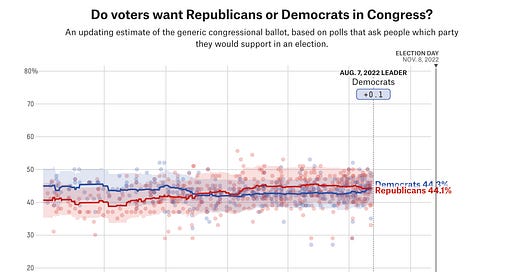Midterms notepad | #204 – August 7, 2022
Kansas, cross-pressured voters, and the changing* political environment
Happy Sunday everyone,
I am deep in work projects this week and organizing a lot of promotion for Strength in Numbers, which launches in the UK and Europe this coming Friday. That means I have only managed to find an hour to write a newsletter on the state of the midterms today. This post is therefore brief, but nevertheless important. I have been asked a few common questions about the race from various reporters, pundits and prognosticators that are worth answering here now for a broader audience.
Start with the national polling. Democrats have now taken a bare lead in FiveThirtyEight’s average of generic ballot polls, up from -3 on this day in June, before the Supreme Court’s Dobbs decision that revoked the federal right to an abortion (though attach the usual caveats about the uncertainty around the average):
This is a big deal. While the entirety of the movement in the aggregate may not be real, at least some of it definitely is. We know the movement is not only due to sampling error or temporal swings in polling bias — such as from changing patterns of partisan nonresponse — because (1) we have a lot of post-Dobbs polls now and (2) polls that weight their samples by party identification or past vote have also shown movement in the race. That’s true for public polls, which get taken into the 538 average, and the small subset of private polls that have been shared with me by pollsters off the record.
However, I advise you not to get carried away. For one thing, there is a long way until the election; Republicans have more than enough time to make up the ground they have lost. Look below and you will see that Democrats led on the generic ballot at this point in 2014 — a year in which they ultimately lost the national popular vote for the house by 6 percentage points.
The 2014 trend is consistent with a dominant historical pattern in midterms where the party in power loses ground between now and election day. That decrease is typically about 3 points on the margin between the parties.
Another factor is that the precise amount of movement is probably less than 3 points. In my average of the aforementioned polls that ensure their samples have a constant partisan balance, Democrats have gained only about 2 points on margin in the polling aggregate, putting them at a deficit still of around 0.5-1 percentage point. A final point is that polls of likely have tended to be more negative for Democrats than polls of registered voters or all adults.
But let’s turn to other data. Polls are noisy, after all. What can other numbers tell us? The big story of the last week was the abortion rights referendum in Kansas. 59% of voters cast ballots against an amendment that would allow the state legislature to pass a ban on abortion before 22 weeks, the current protections ensured by the state constitution.
I have seen many political commentators use this result to argue that Democrats are due for a boost in the generic ballot. Perhaps it will materialize as voters think more about the politics of banning abortion over the next few months.
Here, I would be even more careful. There is little reason to be surprised by the result in Kansas. While a liberal result on a referendum seems striking at first glance (given how red the state is in federal elections), polls forecast the result pretty spot-on. Those same polls also found the Republicans in the lead on the generic ballot with likely voters. The fact of the matter is that there are a lot of people who vote for Republicans who also support abortion rights. And that means the results of the Kansas abortion referendum should not necessarily shift our priors about the midterms.
Yet Democrats still may be able to take advantage of the situation. If our theory of the Kansas outcome is that there are a lot of “cross-pressured” Republican voters who may act more liberally on abortion policy, that could have spillover effects for Democratic candidates. The party should do everything it can to remind voters of the Republicans’ positions on abortion. That could include voting on bills (even performatively) in Congress and state legislatures, or even scheduling more initiatives and referenda at the state level.
There is still a long way to November. But the data suggest Democrats have clawed back some much-needed ground relative to their position a few months ago. In a race that could be fought at the margins, that may end up making all the difference.
Talk to you next issue,
Elliott
Posts for subscribers
If you enjoyed this post please share it — and consider a paid subscription to read additional posts on politics, public opinion, polling and election statistics, and democracy.
Monthly mailbag/Q&A!
The next blog Q&A will go out on the first Tuesday of September, or if someone asks a real banger of a question — whichever comes first. Go to this form to send in a question or comment. You can read past editions here.
Feedback
That’s it for this week. Thanks very much for reading. If you have any feedback, you can reach me at this address (or just respond directly to this email if you’re reading in your inbox). And if you’ve read this far please consider a paid subscription to support the blog.
Democracy by the Numbers is a reader-supported publication. To receive new posts and support my work, consider becoming a free or paid subscriber.






